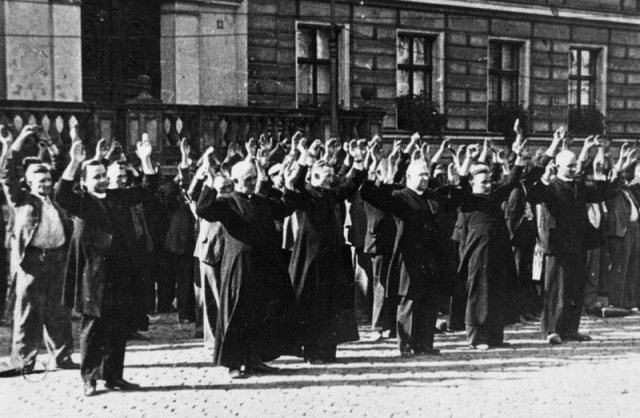|
4/9/2018 0 Comments April 09th, 2018PHOTO ABOVE: Public execution of Polish Catholic priests and civilians in Bydgoszcz Old Market Square, on September 9, 1939, in Poland. Excerpt from Jonathan Huener's "Nazi Kirchenpolitik and Polish Catholicism in the Reichsgau Wartheland, 1939-1941."
"With the invasion of Poland on September 1, 1939, National Socialist Germany aimed to destroy the Polish nation and Polish national consciousness. The Nazi regime attempted to accomplish this in a variety of ways, including the destruction of Polish cultural institutions, forced resettlement, forced labor, incarceration in prisons and camps, random and systematic roundups of prisoners, and mass murder. To the German authorities in occupied Poland and to many Poles, it was obvious that the occupation would target the Polish Catholic Church with vigor and brutality. Catholicism was the religion of approximately 65 percent of interwar Poland's population: it dominated religious life, held tremendous wealth and political power, and its clergy were widely respected as members of the intelligentsia. More importantly for the Germans, the Catholic Church was a locus and symbol of Polish national identity. "The Nazi regime's hostility to the Polish Catholic Church was revealed in discrimination and brutality, but German policy, contrary to what many would assume, was not uniform. The Church suffered less in the General Government -- the German colony established in central Poland -- than in those regions annexed to the Reich, which included eastern Pomerania and the subsequent Reichsgau of Danzig-Westpreussen in the north, Upper Silesia in the south, and the Reichsgau Wartheland or 'Warthegau' in the west. The Nazi agenda of economic, cultural, and racial germanization was pursued most vigorously in these regions, and especially in the Warthegau, where persecution of the Church was most aggressive." VIVA CRISTO REY! Niech żyje Chrystus Król!
0 Comments
Leave a Reply. |
AuthorTHERESA MARIE MOREAU is an award-winning reporter who covers Catholicism and Communism. Archives
October 2023
Categories |

 RSS Feed
RSS Feed